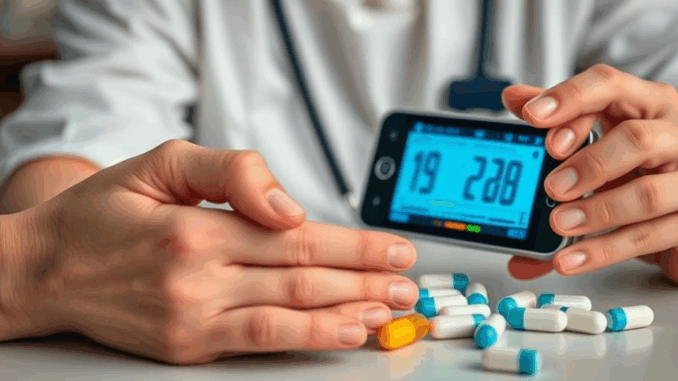
Summary
This article explores the latest advancements in diabetes management, focusing on new medications and technologies. We delve into promising drugs like tirzepatide and sotagliflozin, discuss ongoing research, and highlight the potential of personalized treatment approaches. The future of diabetes care is evolving rapidly, offering hope for improved outcomes and quality of life.
Safeguard patient information with TrueNASs self-healing data technology.
** Main Story**
Alright, let’s talk about diabetes care. It’s truly amazing how much things are changing, isn’t it? Millions worldwide deal with this every day, and thankfully, we’re seeing some real progress in how we manage it. We’re not just talking small tweaks either, we’re talking about potential game-changers that could really improve lives. This article is like a quick peek at what’s new, and what’s coming down the pipeline, especially as we look towards 2025.
New Meds: Shaking Things Up
Type 2 diabetes management has definitely seen some serious upgrades in the past few years. Some of these new medications aren’t just good at keeping blood sugar in check, they’re also helping with weight and even protecting the heart. Pretty impressive, right?
- Tirzepatide (Mounjaro): Okay, this one is a big deal. It’s a first-of-its-kind, working as both a GIP and GLP-1 receptor agonist. It seriously kicks butt when it comes to lowering A1C and helping with weight loss, like, even better than other GLP-1 drugs like Ozempic. Right now, it’s approved for type 2 diabetes, but they’re also looking at it for general weight management, and word on the street is that approval is coming sometime in 2025. It’s got a dual-action thing going on, making it a solid choice for anyone needing a comprehensive approach to managing diabetes.
- Sotagliflozin: Now, this SGLT inhibitor, it’s playing both sides by blocking both SGLT1 and SGLT2 proteins. Besides helping with blood sugar, it’s showing some serious love to the cardiovascular system, reducing the risk of heart attacks, strokes, and even cardiovascular death, especially for people with type 2 diabetes and kidney issues. Honestly, it’s a win-win, especially if you’re dealing with those coexisting conditions.
Tech to the Rescue
But it’s not just about the drugs. Think about the tech that’s transforming how we handle diabetes – it’s becoming way more personal and convenient. I remember my uncle, who’s had diabetes for years, telling me how clunky his old monitor was. The new stuff? Worlds apart.
- Automated Insulin Delivery (AID) Systems: We’re talking artificial pancreas systems here. They keep an eye on glucose levels constantly and tweak insulin delivery automatically. And listen to this, research is showing they’re safe and effective even for older adults with type 1 diabetes! That’s huge because people used to think it might not be suitable for them. The Omnipod 5 and mylife Loop systems, which are tubeless, are expected to pop up in 2025. I think you’ll agree that they’re supposed to be super flexible and easy to use.
- Continuous Glucose Monitoring (CGM): Real-time glucose data and alerts for high or low blood sugar? Yes, please! That’s what CGMs are bringing to the table. Studies are proving they work for a bunch of different people, older adults included.
What’s Cooking in the Labs?
Research never stops, and that’s a good thing because there are even more advanced treatments on the horizon.
- Teplizumab: This immunotherapy could delay the start of type 1 diabetes in people at high risk, and, potentially get the green light in 2025. On the other hand the high cost of the medication might be a problem, limiting access, which is a shame.
- Oral Insulin: Imagine ditching the injections! Researchers are working on an oral insulin formulation. I mean, seriously, that could change everything for people with diabetes and make insulin delivery way less of a hassle, don’t you think?
- Personalized Treatment Approaches: A new tool from the University of Exeter can figure out the best glucose-lowering drug for someone with type 2 diabetes, based on what makes them unique. This approach, well, it could really fine-tune treatment and cut down on complications. If only everything could be this tailored, right?
The Future Looks Promising
So, where are we heading? The future of diabetes care looks bright, wouldn’t you agree? With new drugs, cool tech, and personalized treatments, we’re walking into a new era of hope for people with diabetes. These advancements promise better blood sugar control, management of other health issues, and a better quality of life. Sure, there are hurdles, but ongoing research gives us reason to be optimistic that diabetes can be managed more effectively, minimizing those nasty long-term complications. It’s an exciting time!


Oral insulin, you say? So, are we talking a future where dessert *becomes* the medication? Suddenly, those sugar cravings have a whole new justification… “Doctor’s orders, more cake!”
Haha, that’s a hilarious thought! Doctor’s orders for cake might be a bit *too* good to be true, but oral insulin would definitely be a game-changer for convenience. It’s still early days, but the potential to simplify diabetes management is huge. Imagine the freedom!
Editor: MedTechNews.Uk
Thank you to our Sponsor Esdebe
The potential for teplizumab to delay type 1 diabetes onset is exciting. However, the challenge of equitable access due to high costs needs innovative solutions. Perhaps tiered pricing or government subsidies could ensure this promising immunotherapy reaches those who need it most.